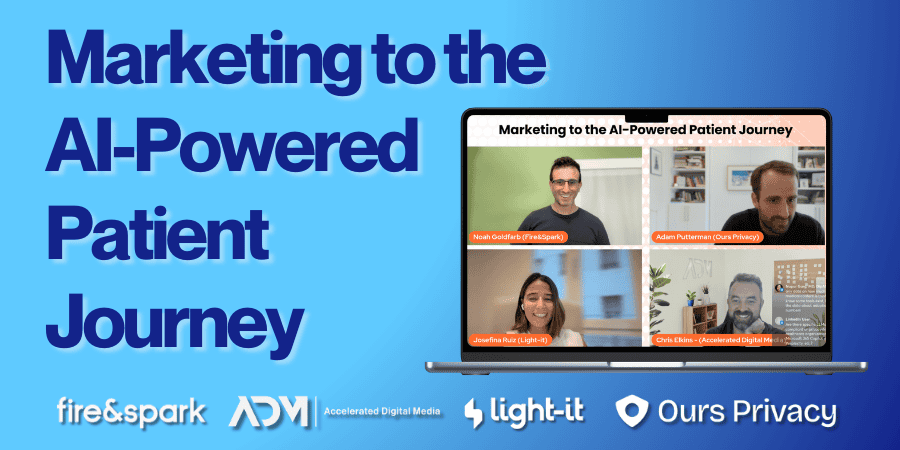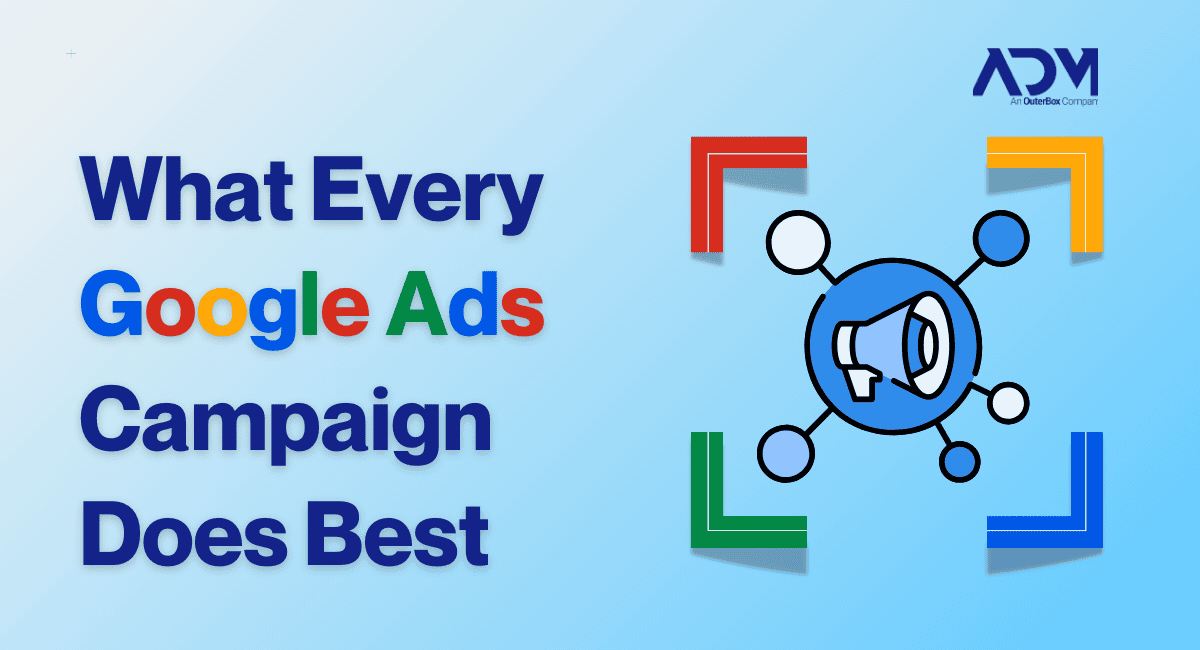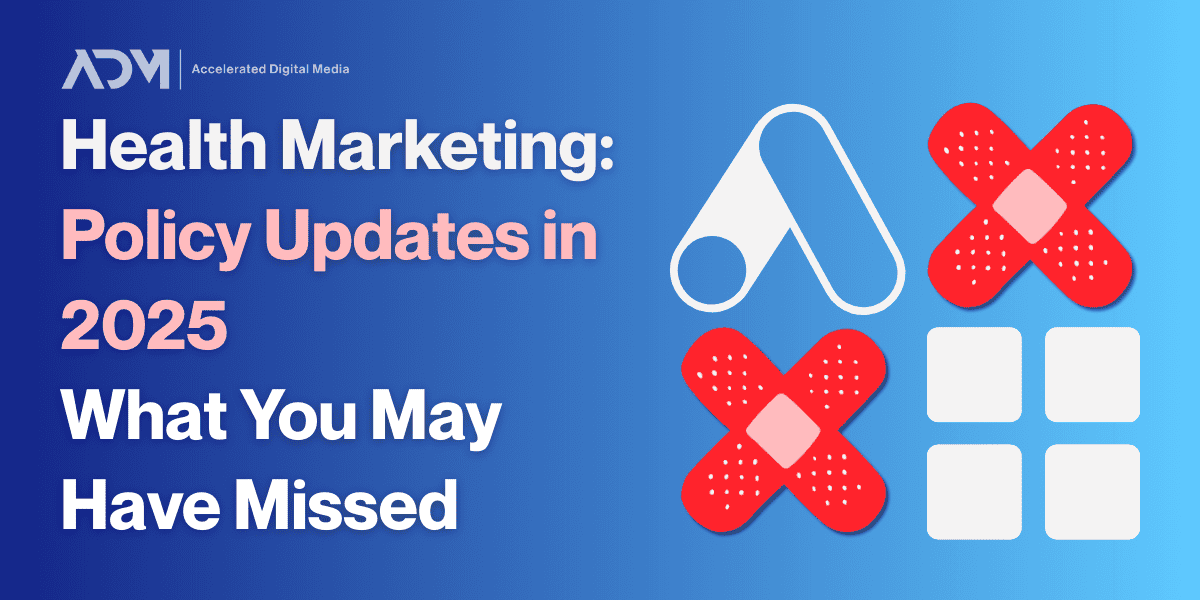A lot of promises have been made about what AI will do to…well, everything. It’s true that artificial intelligence is reshaping the way patients search, how healthcare brands advertise, and how regulators think about compliance. But despite the noise, the shift right now is proving more gradual than revolutionary. That was the consensus from a recent panel ADM co-hosted with a trio of other partners in the health marketing space.
Moderated by Adam Putterman (Ours Privacy) and featuring Noah Goldfarb (Fire&Spark), Josefina Ruiz (Light-it), and ADM’s Chris Elkins, the discussion highlighted a central reality for healthcare marketers: AI adoption is real, but uneven. And success in this new landscape will hinge less on chasing hype than on blending innovation with hands-on expertise.
Are LLMs Changing Patient Research Behaviors?
As a healthcare marketing agency, we focus a lot on how health brands can connect with patients throughout their journey from diagnosis to care selection. Early in that journey, there’s typically a lot of research—but there is concern that large language models (LLMs, like ChatGPT) will siphon traffic away from traditional websites.
While this has had profound impacts in some corners of the internet, Goldfarb and Elkins agreed that LLMs specifically have had less impact so far in the health sphere. Across ADM’s client base, Elkins noted that only about 0.6% of traffic right now is coming from AI tools like ChatGPT and Perplexity.
“These are still small percentages, but it is pretty significant growth from six months ago,” he said. Most of that traffic remains top-of-funnel, however, while bottom-funnel searches continue to run through Google.
Goldfarb, whose agency Fire&Spark focuses on SEO content specifically for the health industry, shared data from a dozen health sites showing that LLM-driven traffic is currently just 1% of what they see from organic search. But that 1% converts at a higher rate: 3–5% versus the 1–2% typical of organic visitors.
A very recent SEMrush study underscores this point: after adopting ChatGPT, users actually increased their weekly Google searches. For Elkins, this signals that, at the moment, AI is supplementing rather than supplanting search—patients seem to be using both in tandem to complement their research, he noted.
“The amount of change in terms of traditional SEO and GEO has been widely overstated,” Goldfarb said. “It’s still about creating high-quality content. It’s proving your excellence. It’s being authoritative.”
AI Options—and Adoption—Might Be Outpacing Utility
While patient adoption of AI search may be gradual, Google and Meta are racing to infuse their ad platforms with AI. The panel agreed that healthcare marketers can’t afford to ignore these changes—but they also won’t benefit much from blind adoption and sudden reliance.
Elkins described the pattern he sees often: “We’re getting more and more potential new partners coming to us with accounts heavily relying on Performance Max and Broad Match—and yet they’re not hitting their goals.”
These AI-powered formats are effective at expanding reach among mid-funnel audiences, but they’re not always the most ideal tools for high-intent queries—particularly given the limitations that health marketers face when deploying campaigns without the data usage liberties that generalist advertisers enjoy. That means health advertisers still require more traditional marketing campaigns (like Exact and Phrase match Google Search campaigns), guided by human judgment.
Goldfarb observes similar temptations and limitations on the content side. Marketers eager to scale AI-written blogs often overlook whether those pages serve any real patient purpose. Content volume alone has never guaranteed patient acquisition, and in the AI era the bar for authority and credibility is only rising.
AI adoption succeeds when it removes friction for patients, not when it replaces strategy. It’s often best served to support health marketing efforts in more subtle ways. Ruiz pointed to intake automation and appointment scheduling as AI features that are both measurable and regulatory-friendly. Even if patients begin their journey with new tools, what ultimately matters is how seamlessly those tools hand off to the care experience itself.
“If AI means less friction—faster intake forms, easier access to services—then I will get more conversions. Soon, if not now, we’re going to require it,” she said. In other words, while AI-driven marketing and content tools haven’t rewritten the research stage, AI-enabled patient experiences will still be an essential cog for providers looking to move patients deeper into their funnel.
Privacy Risks and Concerns
For whatever promise that AI tools may hold in reshaping how patients discover and interact with care, the panelists emphasized that potential privacy risks remain acute in healthcare marketing.
Ruiz argued that, from a product development perspective, digital health organizations need to ask hard questions before adopting any AI solution.
“It’s not only about what data you collect, it’s also what the model does with it, where it travels, how it’s processed,” she said. She highlighted three areas every health marketer should press vendors on:
- Data residency: Can you control where the data lives?
- Data retention: How long is the information stored?
- Training: Is your data going to be used to train the models?
Failing to establish these parameters early can stall an otherwise promising product at the legal review stage, Ruiz cautioned. AI tools embedded into intake, scheduling, or patient engagement must not only meet regulatory standards but also fit seamlessly into clinical and patient workflows. Otherwise, adoption will falter no matter how strong the technical capability is.
Any potential application of AI in health marketing and product development should face appropriate scrutiny before deployment. Health marketers looking to mine ChatGPT for new insights, for instance, need to think long and hard about what information they’re giving to the platform. Any AI-driven workflow must be assumed to be discoverable, auditable, and potentially public.
“People are treating these tools like there’s doctor–patient confidentiality, and that doesn’t exist,” Elkins said. “If subpoenaed, they will hand your conversations over to the government.”
For patients, that means information shared with a chatbot may not be protected the way it would be in a clinical setting. That lack of confidentiality carries real implications for the patient journey. If patients begin researching symptoms or treatment options inside an AI interface, they may be exposing sensitive data without realizing it—which in turn could erode their trust in digital health tools.
Be Deliberate in Your AI Approach
The way many tech evangelists and CEOs speak about current AI capabilities, you’d think the entire marketing landscape had already crumbled and been rebuilt—but it was clear from the tenor of our conversation that the panelists saw things moving much more slowly.
“[There were] a lot of the sirens about AI tools when they first launched—that they’d take over and were going to grow so fast—and I think everything we’re saying is that we haven’t seen that. We have seen a slow and steady adoption,” Elkins said.
The other panelists concurred with this outlook. Goldfarb noted that, for instance, AI isn’t killing off search as a means through which patients find out about health companies. But it is killing off a lot of higher-to-mid-funnel informational queries and forcing everyone to rethink what search means.
Ruiz underscored that it was ultimately about due diligence and preparedness. Even if these technologies aren’t turning the industry on its head yet, they will undoubtedly find their footing in the long term.
“Where we’re seeing people win with AI is going to be responsible adoption,” Elkins said. “There’s a right way to use the AI tools and a wrong way. One of the wrong ways is no adoption.”



